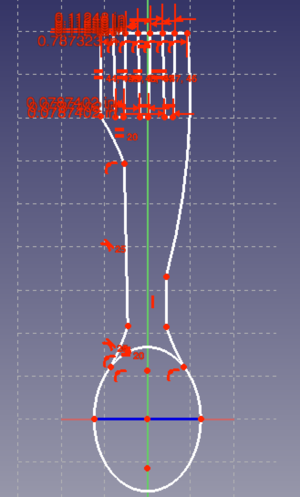A Better Spork with a Better Knife
A better way to eat
Project developed by Forest.andresen (talk) 13:20, 25 April 2017 (PDT) Add a status meter by copying the following templates (inside double curly brackets) into your page as you reach each step: status-design, status-prototype, status-deployed, status-model and status-verified....
Template:Statusboxtop Template:Status-design Template:Status-prototype You can help Appropedia by contributing to the next step in this OSAT's status. Template:Boxbottom
Abstract
- Everyone eats, some eat with their hands, and some eat with utensils. This is a project focusing around bringing the best utensils to people worldwide, without the usual cost involved. This is the creation of a utensil that can be easily printed by a 3D printer anywhere around the world. Our wish at project spork is to enable all to have a clean and convenient eating experience. The better spork is made to be east to clean and to have significantly better cutting ability than any other spork/knife to date.
- Picture of completed print using [[Image:|200px|right]]
Bill of Materials
- Provide a full BOM -- This part needs only a 3D printer and a filament that is non toxic.
- Upload and link to all source files from open source CAD
- Upload and link to all STLs
Tools needed for fabrication of the OSAT
- A 3D printer
Skills and Knowledge Necessary to Make the OSAT
- You simply need to be able to download and the part and use a 3D Printer to make it.
Technical Specifications and Assembly Instructions
- This device does not need assembly, and will be able to be used right off the print bed.
- Print time: approx. 30 minutes
- drawing below:

- no video yet
| Example video summary of textbook |
|---|
Error in widget I have not added a video yet: Unable to load template 'wiki:I have not added a video yet' |
Common Problems and Solutions
- I recommend including a brim to ensure the spork does not peel off the build plate while printing. This will someone to chip off the brim when the spork comes out.
Cost savings
- If your solution is not a low cost one then it is not really appropriate.
- Estimate your costs
- Find a commercial equivalent
- Calculate $ savings and % savings
References
- The sources of information (e.g. engineering handbooks, journal articles, government documents, webpages, books, magazine articles etc.). References should use the <ref> </ref> and <references/> tags and can be in any format but should include all the information necessary for someone else to find the same information you did. For example: [1]
- ↑ web page: Department of Energy (DOE) Landscaping and Energy Efficiency, DOE/GO-10095 (1995) Available: http://www.eren.doe.gov/erec/factsheets/landscape.html
Based on the developmental needs addressed (e.g. food, heat, electricity, clean water, health care, etc.) be sure to label your device in the proper categories e.g. use [[Category:Water]]. Be sure to categorize your device so that it will be easy to find – for example “Low voltage connection basics” is categorized in [[Category:How tos]] [[Category:Electricity]] [[Category:Electric lighting]].